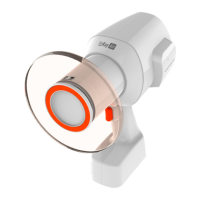4. Operation
34 EzRay Air Portable (Model: VEX-P300) User Manual
Positioning the Imaging Sensor
Using EzRay Air Portable (Model: VEX-P300), a portable dental X-ray system, you
may create an X-ray image on different types of imaging receptors:
• Digital sensors
• Phosphor plate
To ensure image quality, the digital imaging sensor must be appropriately positioned
(for information about the imaging sensor's proper placement, please refer to
‘Positioning Instructions.’
• Failure to position the imaging sensor correctly can result in errors on the
radiograph, such as distorted teeth and roots, elongation, magnification, and
overlapping contacts.
The paralleling technique generally reduces the risk of such
errors, but if the sensor's position improperly, angulation errors
may occur (angulation of the sensor to the tooth itself).
• Failure to align the imaging sensor with the X-ray beam's exit pattern can result in
cone-cuts on the radiograph. The cone-cuts are bright areas shown on the
radiograph when part of the radiograph is not exposed to radiation. Please refer to
the following figure as an example of cone-cuts.
The following figure indicates how the cone-cut occurred by showing the imaging
sensor's position and the radiation area.
Cone-cut
Cone-cut

